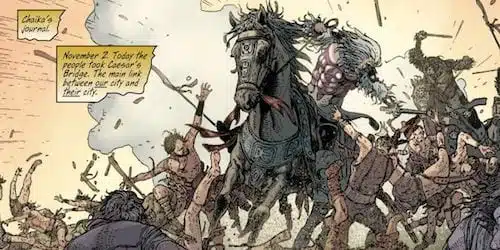
“It is absolutely essential that the oppressed participate in the revolutionary process with an increasingly critical awareness of their role as subjects of the transformation.”
— Paulo Freire
Paulo Freire, the Brazilian educator and theorist of critical pedagogy, is one of the most influential educational thinkers of the late 20th century. He advocated that education should allow the oppressed to regain their humanity and overcome their condition of inferiority. His most well-known work, Pedagogy of the Oppressed, argues for a system of education that emphasizes learning as an act of culture and freedom.
This philosophy of education, it can be argued, plays an important role in the continuing Planet of the Apes saga from BOOM! Studios. As the people of Skintown struggle to hold on to their humanity on the outskirts of the ape-populated city of Mak, an education is taking place among the youngest generation of the ghetto.
Picking up where issue #2 left off, Planet of the Apes #3 continues with “The Long War” storyarc. The humans are about to face off against Nix and his White Troops at the bridge that links the human ghetto and Mak. The battle does not take place, however, as Sullivan withdraws her people after Nix threatens to wipe them all out. And with the firepower that the White Troops have, it was a wise move. We’re talking giant, menacing airships with gun-toting apes. Carlos Magno continues to create stunning scenes like this one, with the shadows of the blimps hovering over the humans, just waiting to fire down on them.
And writer Daryl Gregory certainly knows how to draw out the tension, allowing it to slowly build over the series, all of the proper events aligning to the inevitable war that will tip the balance between apes and humans. It really is beautifully done. Character development is his strong suit as well.
This issue foreshadows a bigger role for Bako as he clashes with his daughter Chaika about how best to handle Nix and the rest of the apes, illustrating a disconnect in the generation gap that proves to be important to the story.
Chaika figures prominently in this issue, with some surprising revelations coming to light. A symbol of what the humans eventually become by the time Charlton Heston’s Taylor crash lands among the apes in the 1968 Planet of the Apes movie – ignorant, mute shells of themselves – she is the symbol of Freire’s philosophy as well. Instead of simply accepting her muteness, she has learned sign language and has become increasingly vocal about humans’ place in ape society.
As one of the Silents, Chaika and the rest of Skintown’s youth take refuge in the words of Brother Kale, the mysterious leader of a bomb-worshipping congregation. “It’s not the bomb we worship.” Kale says, “It’s the idea it represents.” In the post-apocalyptic world of Planet of the Apes, education, be it nontraditional, is something that is not taken lightly, especially if it brings power.
